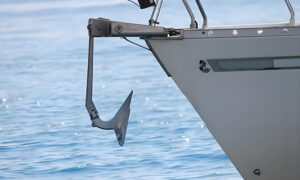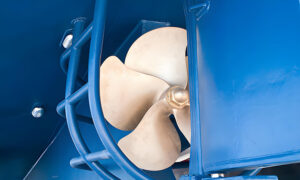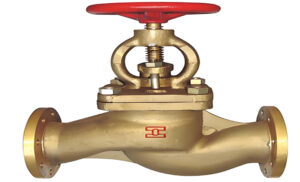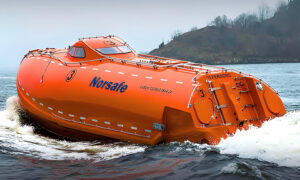Various kinds of deck equipment are put on the ship’s deck whether for anchoring, mooring, loading, or unloading. For those professional maritime operators, learning about the functions and locations of deck hardware is truly essential. That can help them to deal with tasks efficiently and navigate precisely.
Functions of Deck Equipment on Ships

Marine deck equipment includes various tools and mechanisms, and they are essential to maritime operations and security. These components are installed on the ship’s deck strategically to provide multiple functions such as anchoring, mooring, cargo loading, and emergency operating. Some common kinds of vital deck machinery on ships are as follows:
Anchors: Anchors for ships are basic devices designed for keeping the stationary of ships when they are not in movement or mooring. Typically, the marine anchors are placed in the front of the ship and deployed by anchor chains. This tool provides stability and avoids the movements of vessels.
Mooring Winches: Mooring winches have the capability to secure the ship to a dock or another ship. In common conditions, these winches positioned near the bow and stern. They are used for assisting in adjusting the tension of mooring lines, and ensure a solid connection during docking operations.
Cranes: Cranes help to handle missions of loading and unloading cargo. These facilities are used to be convenient for efficient loading and unloading operations. Thus, larger vessels may install not only one cranes on their decks to meet their different goods requirements.
Bollards and Cleats: Bollards and cleats are fixtures mounted on the deck along the ship’s sides. They serve as sturdy points for securing mooring lines and ropes during docking and mooring processes. These components play a crucial role in ensuring the ship remains securely anchored at ports.
Davit Systems: Davit systems are designed for launching and recovering lifeboats and other small vessels. These systems, commonly located near lifeboat stations, are indispensable for the swift and safe deployment of emergency craft during critical situations.
Navigation Lights and Signaling Equipment: Navigation lights and signaling equipment are also crucial parts on deck for keeping marine visibility and communications with other ships. These lights are placed on the superstructure of vessels. The purpose of the way is to conform with the maritime laws and regulations as well as enhance navigation safety.
Tailored Deck Equipment Solutions for Diverse Ship Types

The design of marine deck equipment has its specific functions so that they can cater various demands from different kinds of ships. For example, cargo ships prefer stockless anchors, fishing ships need admiralty anchors, and recreational boats would like to use Danforth anchors. That means the deck building supplies offers respective anchoring solutions for vessels with diverse sizes and functions.
Mooring winches come in electric, hydraulic, and manual variations. Electric winches are ideal for large container ships and oil tankers, hydraulic winches are suited for heavy-duty vessels like offshore support ships, and manual winches are commonly found on smaller boats such as fishing vessels and tugboats.
Cranes play a pivotal role in cargo handling, with gantry cranes typically used on container ships and bulk carriers, deck cranes on multipurpose vessels and offshore supply ships, and jib cranes on smaller cargo ships and workboats.
Bollards and cleats include single bollards, double bitt bollards, and horn cleats. Each of them caters to different mooring requirements. Single bollards are versatile, and they are prevalent in multiple vessels. Double bitt bollards provide solid mooring points for larger tankers and bulk carriers while horn cleats can fix smaller lines efficiently, so they are also adapted to various types of ships.
Davit systems, from gravity davits for smaller vessels to mechanical davits for larger ships like passenger ferries and cruise liners and free-fall davits for rapid deployment on offshore platforms, ensure the safe and efficient launching and recovery of lifeboats and small vessels in different maritime scenarios. That enhances operational effectiveness and safety in maritime environments.
Factors to Consider When Selecting Deck Equipment for Ships

Choosing the appropriate deck equipment for ships involves a comprehensive evaluation process to ensure that the selected tools align with the vessel’s operational requirements and safety standards. One of the critical aspects to consider is the specific needs of the vessel type and size. Different types of ships, such as cargo vessels, tankers, passenger ships, and offshore support vessels, have unique demands that require tailored deck machinery solutions.
Operational requirements are another key consideration. The selection of deck equipment should be based on the expected usage and functions. For instance, the selection of cargo handling equipment like cranes is determined according to the common cargo types and quantities. Meanwhile, the choice of mooring winches also need to meet the mooring demands of ships, as well as thinking about other factors like mooring locations and environmental conditions.
The quality and reliability are also important. Investing in well-known manufacturers and using high-quality equipment can ensure durability and long-term performance of deck hardware. Additionally, reliable equipment is significantly vital to the security and efficiency of ships. They can reduce the risk of downtime and maintenance because of their impacts on maritime operations.
Safety features should also be a top priority when choosing deck building supplies. Equipment with built-in safety mechanisms, such as emergency stop buttons, overload protection, and anti-slip surfaces, can help prevent accidents and injuries on board. Safety certifications and compliance with industry standards should be verified to ensure that the equipment meets regulatory requirements.






